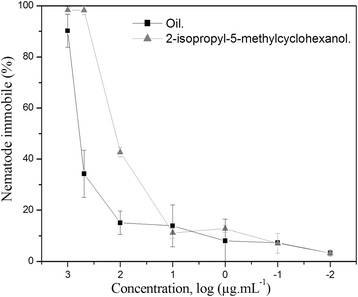Nematicidal activity of Annona crassiflora leaf extract on Caenorhabditis elegans
- PMID: 25885032
- PMCID: PMC4336742
- DOI: 10.1186/s13071-015-0708-6
Nematicidal activity of Annona crassiflora leaf extract on Caenorhabditis elegans
Abstract
Background: The aim of this work was to investigate the potential nematicidal activity of Annona crassiflora leaf extract against Caenorhabditis elegans.
Methods: The hydroalcoholic leaf extract and its fractions (dichloromethane, ethyl acetate, methanol and water) were submitted to mobility assay against the roundworm Caenorhabditis elegans. GC-MS and NMR analysis were performed in order to identify metabolites.
Results: The dichloromethane and ethyl acetate fractions showed to be the most active among the hydroalcoholic leaf extracts and its four fractions. The percentages of C. elegans larvae immobility were 98.13 and 89.66%, respectively, at a concentration of 1000 μg.mL(-1). Besides some amino acids, palmitic acid methyl ester, 2-isopropyl-5-methylcyclohexanol, oleic acid methyl esther, stearic acid methyl ester, quercetin and kaempferol were also identified in these fractions.
Conclusion: The results indicated that of A. crassiflora leaf ethanolic extract has a good potential as a source for natural nematicide.
Figures


References
Publication types
MeSH terms
Substances
LinkOut - more resources
Full Text Sources
Other Literature Sources
Miscellaneous

